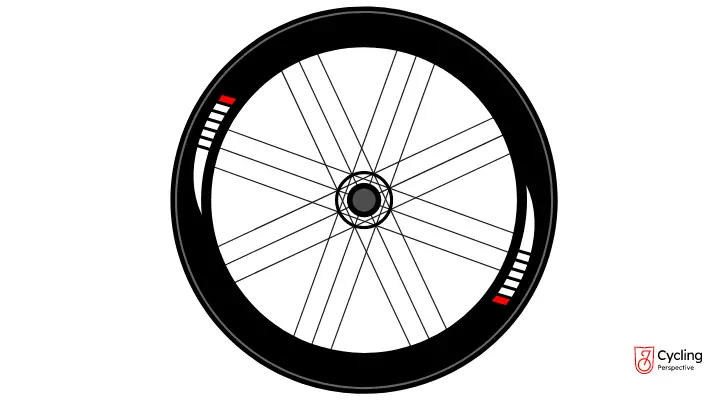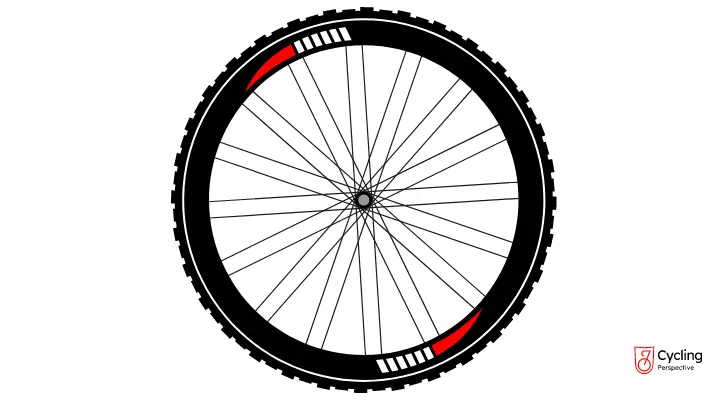You can’t get far without good tires. And what makes a pair of tires good depends on the type of bike you ride.
Road bikes are all about aerodynamics and speed on paved roads, and they necessitate skinny, light tires that are inflated at high pressure and offer the rider minimal rolling resistance.
Mountain bikes are all about endurance and grip off-road. So they need a very different type of bulky, heavy tires that are inflated at low pressure and offer the mountain biker maximum traction and grip.
Whether you’re just getting into cycling or you’re an experienced rider looking to expand your knowledge of bikes: This post will tell you everything you need to know about the difference between road and mountain bike tires (and why it matters).
Road Bike Tires

Road bikes, whether speed or endurance, are bikes that can take you as far and as fast as your legs will allow… as long as you keep to paved roads.
These bikes sport a sleek look and have compact tires to keep the wheels, the frame, and the rider’s body as aerodynamic as possible at all times, reducing drag and facilitating higher speed.
Road bike tires have supple carcasses and boast high thread counts, 60 TPI or higher, to preserve ride feel while delivering good protection against punctures. The best of them feel as supple as leather gloves—and nevertheless outlast their cheaper counterparts by age and mileage.
Typically, road bike tires have no treads. They’re meant for use on dry, asphalt roads, where treads have little to no utility. This is why they are not directional (even if some manufacturers print an arrow on the sidewall to avoid confusion).
When selecting tires for a road bike, look for a high single-ply thread count, preferably 60 or above, and reinforced sidewalls. Kevlar beads are expensive but offer extra protection against punctures.
These tires are narrow and they inflate to a high tire pressure.
Most road bike owners will pump their tires to 90-120 PSI, though professional cyclists can sometimes inflate theirs to as high as 160 PSI (learn more about bike tire pressure).
Generally speaking, there are three types of road bike tires:
- Clinchers are tires that clinch to the rim and need inner tubes to hold air.
- Tubulars, also known as “sew-ups” stateside, are tires stitched together with the inner tubes to form a torus.
- Tubeless tires, on the other hand, are tires that, very like much car tires, fit firmly against the rim and don’t require inner tubes to hold air.
The inner tubes can be made of butyl rubber or latex. As a general rule, butyl tubes are best for everyday cycling thanks to their durability, whereas latex tubes are ideal for racing thanks to their lightweightedness.
Since latex is more porous than butyl rubber, air escapes from latex tubes faster than it does from butyl tubes. Riders who’ve fitted their bikes with latex inner tubes should therefore check the tire pressure and top up with air before every ride.
There’s much debate about which type of road bike tire is better: clincher, tubular, or tubeless. Recreational cyclists use clinchers and tubeless tires, usually because of their affordability, whereas the pros use tubulars because they are the most airtight.
The standard diameter for road bike tires is 622 mm on the bead. More often than not, manufacturers use the reference code 700c—a holdover from a French tire sizing system that’s no longer in use—to indicate this diameter.
For decades, the standard width for road bike tires was considered to be 23 mm. However, an increasing number of cyclists these days are opting for wider tires in the range of 25-26 mm, even 28 mm.
What width tires to get depends on your road bike’s purpose. Racing bicycles benefit from narrower tires for resistance-free roll, whereas touring and gravel bikes from wider tires for traction and grip.
Mountain Bike Tires

Mountain bikes are all about extremes. And, as any mountain biker can attest to, you can’t ride in extreme terrain or extreme weather without tires that can handle it.
Sturdy and equipped to handle it all, mountain bikes require hefty tires that can provide maximum grip, absorb shocks from tall jumps, and resist penetration from sharp objects (for all else, carry a patch kit or Slime sealant).
When selecting MTB tires, look for low-TPI tires with kevlar belts. These tend to offer the best balance between price and durability.
These tires are wide and they inflate to a low tire pressure.
Most mountain bike owners will pump their tires to 30-50 PSI, on some occasions even lower than that. On hybrid bikes, it isn’t unusual to pump up the tires to 50-70 PSI.
The best mountain bike tires balance between good grip, quick braking, and minimal rolling resistance so that you can ride, turn, climb, and jump safely and confidently that the rubber on your wheels won’t fail you in the moments when you need it the most.
MTB tires come in all shapes and forms, with diameter, width, and tread design being the biggest differentiators. The diameter depends on the size of the rim; the width depends on the use of the bike.
The ideal width of MTB tires varies with the bike’s use (REI):
- Cross-country bikes have narrow tires, typically in the range of 1.9″ (4.8 cm) to 2.25″ (5.7 cm).
- Trail and all-mountain bikes have semi-narrow tires, typically in the range of 2.25″ (57 mm) to 2.4″ (6 cm).
- Downhill bikes have semi-wide tires, typically in the range of 2.25″ (5.7 cm) to 2.5″ (6.3 cm).
- Fat bikes have wide tires, typically in the range of 3.7″ (9.4 cm) to 5″ (12.7 cm) and wider.
The tread design also matters. Tires with short treads spaced close together roll faster but offer less grip. Tires with tall threads spaced out have more traction on mud and loose dirt but roll with greater resistance.
Some tires are front-only tires. They are designed to give grip, traction, and minimal rolling resistance specifically for the front wheel so you can race downhill and ride trails at fast speeds, taking tight corners, and braking safely.
Conversely, other MTB tires are rear-only tires. These tires are designed for optimal traction in turns, excellent grip when climbing, and better braking before turns and after steep descents.
For the same reasons, mountain bike tires are directional. There’s an arrow on the sidewall that indicates which way the tire should rotate. Sometimes, there are two arrows; one for the direction when the tire’s mounted on the front wheel and the other for when it’s mounted in the rear.
